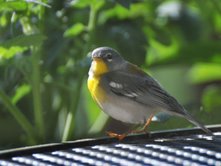A female Ruby-throated Hummingbird is building a nest on the branch of a large pine tree at the corner of our back yard. The nest is far out on the branch from the trunk, but under several other branches with some green needles that arch over it and may provide some shelter.
At first, the nest looks like just a grayish lichen-covered lump. I saw her fly into it by chance, when I had walked out onto the deck early this morning, and then watched as she made several trips to and from the nest, not staying gone for more than a few seconds at a time, and returning each time with something she applied to the rim and sides of the nest.
After a few minutes, I brought out my scope and was able to watch her for about an hour as she worked quickly and continuously and energetically.
What I can see of the nest looks like brown catkins covered with an outer layer of gray-green lichens and silk from spider webs.* I could not see inside the nest, except for little fluffy tufts of something sticking up that may be dandelion tufts or similar material. As I watched, she left for only a few seconds at a time and usually came back with spider-web silk in her bill – often with sticky strands streaming over her head and down her neck, too. Spider-web silk also extends up and down the branch from the nest.
Each time she returned, she sat in the nest and used her bill to apply the silk to the rim or outer sides, wiping her bill over the nest surface, and sometimes flicking out her tongue. Once she preened her rump feathers with her bill and then wiped it over the side of the nest. Sometimes she brought small tufts of other material and deposited it inside the nest with a vigorous stabbing motion.
Every time she came to the nest, after she had applied whatever materials she had brought, she wiggled around in the nest and seemed to be using her feet and belly to help press down the materials or shape the inside.
All of her feathers looked a little rumpled or ruffled up, on top of her head, and on her back, and this appeared to be because of her exertions. Her back and head were iridescent green. White showed around the outer corners of her eyes, giving her a wide-eyed look, and on her pale throat were subtle radiating rows of small soft spots. Every once in a while I heard her twitter, but she never came to the feeder while I was watching, and rarely seemed to be gone long enough to eat. During this time, she seemed entirely focused on nest building – though once she stayed gone for as long as a minute.
I have not yet seen a male Ruby-throated Hummingbird here, and saw no sign of one this morning as the female worked on her nest.
*The species account in Birds of North America Online says the nest usually is constructed of plant down such as thistle and dandelion, or bud scales, covered in lichen and all held together with spider webbing. So maybe what looks like catkins to me is scales or thistle. The account also says the nest is constructed by the female alone, and that she usually begins building it on arrival in the breeding area.
T.R. Robinson, R.R. Sargent and M.B. Sargent. 1996. Ruby-throated Hummingbird (Archilochus colubris), The Birds of North America Online (A. Poole, Ed.) Ithaca: Cornell Lab of Ornithology.
